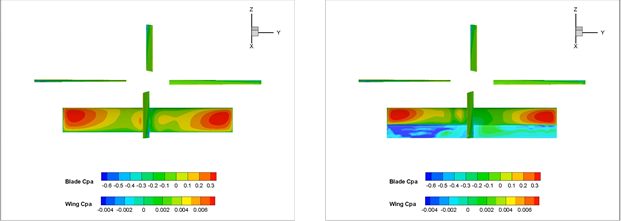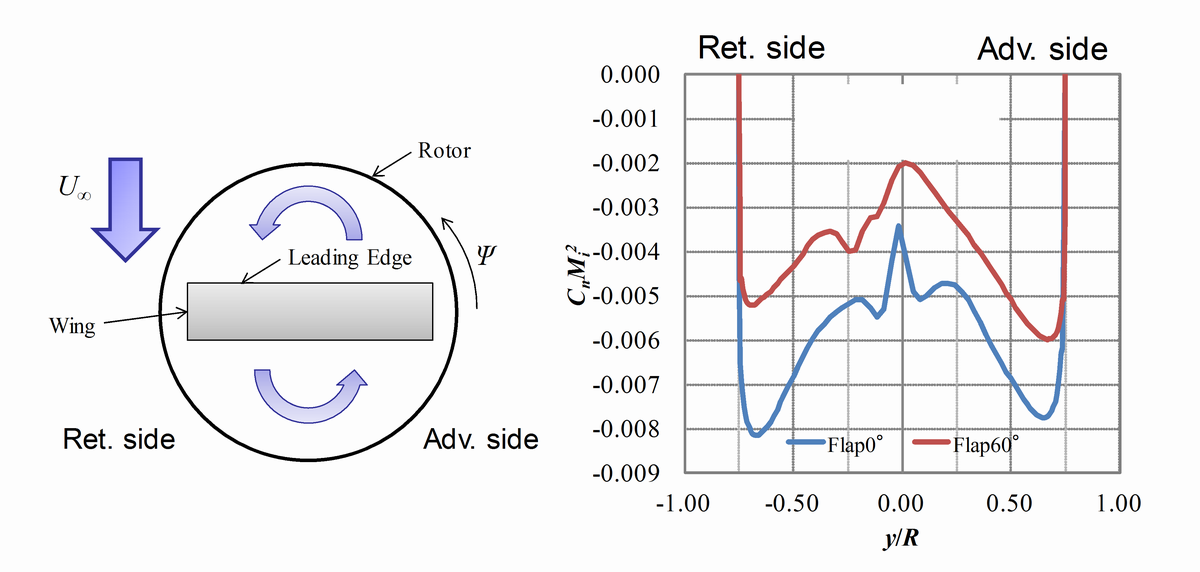Conceptual Study of a High Speed Compound Helicopter for Innovative Air Transportation
JAXA Supercomputer System Annual Report April 2016-March 2017
Report Number: R16E0037
- Responsible Representative: Yoshikazu Makino(Next Generation Aeronautical Innovation Hub Center, Aeronautical Technology Directorate)
- Contact Information: Yasutada Tanabe(tan@chofu.jaxa.jp)
- Members: Masahiko Sugiura, Yasutada Tanabe, Hideaki Sugawara
- Subject Category: Aviation(Aircraft)
Abstract
In Fiscal Year 2016, aerodynamic data of a conceptual model that has been flight tested are obtained and used to validate the CFD tool rFlow3D developed for rotorcraft. The aerodynamic interactions between a main rotor and a wing are simulated. Reduction of the downloading on the wing by a trailing edge flap is evaluated.
Goal
To realize a high speed EMS helicopter that fits the geometrical characteristics of Japan and can be used worldwide, a new concept of high speed compound helicopter is proposed and studied at JAXA. Feasibility study is carried out through numerical simulations and tests using scaled models. Constructions of tools for conceptual design, optimal design are performed and the key technologies are identified and investigated.
Objective
The high speed compound helicopter concept proposed by JAXA is to use a pair of electric driven propellers on the wing-tips to generate the required anti-torque for the main rotor. In high speed flight, the lift from the wing will help to reduce the drag of the main rotor and the propulsive force will be provided by the aft-mounted propeller. This concept is going to be proven using scaled-down models through flight test. CFD tools will be validated with the aerodynamic data from wind tunnel testing. JAXA aims to contribute to the realization of a high speed EMS helicopter through constructions of analysis tools for the conceptual design, optimal design, and providing key technologies to the aircraft manufacturers.
References and Links
Please refer ‘Future type rotary-airfoil airplane system technology | Sky Frontier – Sky Frontier Program | Aeronautical Technology Directorate‘.
Use of the Supercomputer
The supercomputer is necessary to carry out these large-scale, multiple test case simulations.
Necessity of the Supercomputer
The utilization of the supercomputer in JAXA was a pre-emptive for this project. It is a must requirement in the conceptual and optimization design stage of such a complex aircraft.
Achievements of the Year
The pressure distributions on the wing upper surfaces during hovering flights are shown in Fig. 1. The left wing has no flap while the right wing has a flap at 60 degrees. The pressure is high near the wing tips. When there is a flap, the pressure on the flap surface is low which explains the mechanism of the lower download when a flap is actuated. Also, the download distributions on the wing in span wise direction are shown in Fig. 2. When there is a flap, the download is reduced. The download distribution is not symmetric because of the rotor rotation, which cause a swirl together with the downwash in the rotor wake.
Publications
Non peer-reviewed articles
1) Yasutada Tanabe, Takashi Aoyama, Masahiko Sugiura, Hideaki Sugawara, Shigeru Sunada, Koichi Yonezawa and Hiroshi Tokutake, ‘Numerical Simulations of Aerodynamic Interactions Between Multiple Rotors,’ 42nd European Rotorcraft Forum, Lille, France, September 6-9, 2019.
2) Masahiko Sugiura, Yasutada Tanabe, Takashi Aoyama, Biel Ortun, and Joelle Bailly, ‘An ONERA/JAXA Co-operative Research on the Assessment of Aerodynamic Methods for the Optimization of Helicopter Rotor Blades, Phase II,’ 42nd European Rotorcraft Forum, Lille, France, September 6-9, 2019.
3) Atthaphon Ariyarit, Masahiko Sugiura, Yasutada Tanabe, and Masahiro Kanazaki, ‘DESIGN OPTIMIZATION OF HELICOPTER BLADE USING CLASS SHAPE FUNCTION BASED GEOMETRY REPRESENTATION,’ ICAS2016,30th Congress of the International Council of the Aeronautical Sciences, DCC, Daejeon, Korea, Sept. 25-30, 2016.
4) Takashi Aoyama, Yasutada Tanabe, Noboru Kobiki and Masahiko Sugiura, ‘A Review of Research on Helicopter Aerodynamics and Aeroacoustics at JAXA,’ The 5th Asian/Australian Rotorcraft Forum, Singapore, Nov. 17-18, 2016.
5) Yasutada Tanabe and Hideaki Sugawara, ‘Numerical Simulation of Aerodynamic Interaction Between a Rotor and a Wing,’ The 5th Asian/Australian Rotorcraft Forum, Singapore, Nov. 17-18, 2016.
6) Masahiko Sugiura, Yasutada Tanabe, Noboru Kobiki and Takashi Aoyama, ‘Flight Test of a Model Size Compound Helicopter,’ The 5th Asian/Australian Rotorcraft Forum, Singapore, Nov. 17-18, 2016.
7) Masatoshi Inaba, Takeshi Akasaka, Takuya Furuta, Noboru Kobiki and Yasutada Tanabe, ‘Experimental Investigation of the Rotor-Wing Aerodynamic Interaction on a Compound Helicopter in Hover,’ The 5th Asian/Australian Rotorcraft Forum, Singapore, Nov. 17-18, 2016.
8) Atthaphon Ariyarit, Masahiko Sugiura, Yasutada Tanabe and Masahiro Kanazaki, ‘Helicopter Blade Design for Forward Flight Using Hybrid Surrogate Model Based on Multi-Fidelity Efficient Global Optimization,’ The 5th Asian/Australian Rotorcraft Forum, Singapore, Nov. 17-18, 2016.
9) Koichi Yonezawa, Naoki Yoshida, Kazuyasu Sugiyama, Hiroshi Tokutake, Yasutada Tanabe and Shigeru Sunada, ‘Development of a Multicopter with Ducted and Variable Pitch Rotors,’ The 5th Asian/Australian Rotorcraft Forum, Singapore, Nov. 17-18, 2016.
Computational Information
- Parallelization Methods: Thread Parallelization
- Process Parallelization Methods: n/a
- Thread Parallelization Methods: OpenMP
- Number of Processes: 1
- Number of Threads per Process: 32,12
- Number of Nodes Used: 1
- Elapsed Time per Case (Hours): 1000
- Number of Cases: 20
Resources Used
Total Amount of Virtual Cost(Yen): 1,859,213
Breakdown List by Resources
| System Name | Amount of Core Time(core x hours) | Virtual Cost(Yen) |
|---|---|---|
| SORA-MA | 944,205.84 | 1,552,739 |
| SORA-PP | 24,378.59 | 208,144 |
| SORA-LM | 9.92 | 223 |
| SORA-TPP | 0.00 | 0 |
| File System Name | Storage assigned(GiB) | Virtual Cost(Yen) |
|---|---|---|
| /home | 328.22 | 3,096 |
| /data | 8,118.95 | 76,586 |
| /ltmp | 1,953.13 | 18,423 |
| Archiving System Name | Storage used(TiB) | Virtual Cost(Yen) |
|---|---|---|
| J-SPACE | 0.00 | 0 |
Note: Virtual Cost=amount of cost, using the unit price list of JAXA Facility Utilization program(2016)
JAXA Supercomputer System Annual Report April 2016-March 2017




